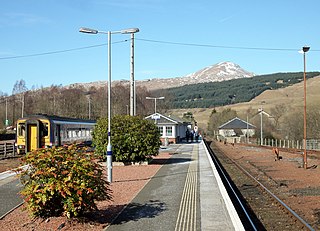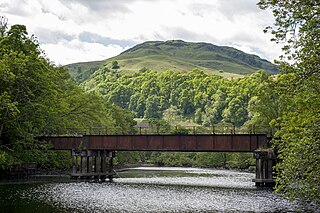
The Caledonian Railway (CR) was a major Scottish railway company. It was formed in the early 19th century with the objective of forming a link between English railways and Glasgow. It progressively extended its network and reached Edinburgh and Aberdeen, with a dense network of branch lines in the area surrounding Glasgow. It was absorbed into the London, Midland and Scottish Railway in 1923. Many of its principal routes are still used, and the original main line between Carlisle and Glasgow is in use as part of the West Coast Main Line railway.
The Callander and Oban Railway company was established with the intention of linking the sea port of Oban to the railway network. This involved a long line from Callander through wild and thinly populated terrain, and shortage of money meant that the line was opened in stages from 1866 to 1880.

Oban railway station is a railway station serving Oban in Scotland. It is the terminus of one branch of the highly scenic West Highland Line, sited 71 miles 44 chains (115.1 km) from Callander, via Glen Ogle. It was originally the terminus of the Callander and Oban Railway. All services are operated by ScotRail, who also manage the station.

Tyndrum Lower railway station is one of two railway stations serving the small village of Tyndrum in Scotland, the other being Upper Tyndrum. This station is on the Oban branch of the West Highland Line, originally part of the Callander and Oban Railway. It is sited 34 miles 70 chains (56.1 km) from Callander via Glen Ogle, between Crianlarich and Dalmally. ScotRail manage the station and operate all services.

Stirling railway station is a railway station located in Stirling, Scotland. It is located on the former Caledonian Railway main line between Glasgow and Perth. It is the junction for the branch line to Alloa and Dunfermline via Kincardine and is also served by trains on the Edinburgh to Dunblane Line and long-distance services to Dundee and Aberdeen and to Inverness via the Highland Main Line.

Dunblane railway station serves the town of Dunblane in central Scotland. It is located on the former Scottish Central Railway, between Stirling and Perth and opened with the line in 1848. It is the northernmost station on the National Rail network to be electrified.

Crianlarich railway station is a railway station serving the village of Crianlarich in Scotland. It is located on the West Highland Line, sited 41 miles 25 chains (66.5 km) from Craigendoran Junction, near Helensburgh, with Ardlui to the south, and Tyndrum Lower and Upper Tyndrum to the north west, on the routes to Oban and Mallaig respectively, which diverge immediately north of the station. ScotRail, who manage the station, operate most services.

Connel Ferry railway station is a railway station serving the village of Connel in western Scotland. This station is on the Oban branch of the West Highland Line, originally part of the Callander and Oban Railway, between Oban and Taynuilt, sited 65 miles 30 chains (105.2 km) from Callander via Glen Ogle. All services are operated by ScotRail, who also manage the station.

North Connel was a railway station located in North Connel, Argyll and Bute, on the north shore of Loch Etive. Its location was at the north end of Connel Bridge. It was on the Ballachulish branch line that linked Connel Ferry, on the main line of the Callander and Oban Railway, with Ballachulish.

Benderloch was a railway station located in Benderloch, Argyll and Bute, on the north east shore of Ardmucknish Bay. It was on the Ballachulish branch line that linked Connel Ferry, on the main line of the Callander and Oban Railway, with Ballachulish.

Appin was a railway station in Scotland, close to the Sound of Shuna on the east shore of Loch Laiche - an arm of Loch Linnhe, Portnacroish, Appin in Argyll and Bute. It was on the Ballachulish branch line that linked Connel Ferry, on the main line of the Callander and Oban Railway, with Ballachulish.

Kentallen was a railway station at the head of Kentallen Bay, which is on the southern shore of Loch Linnhe in the Highland council area of Scotland. It was on the Ballachulish branch line that linked Connel Ferry, on the main line of the Callander and Oban Railway, with Ballachulish.

Callander was a railway station located in Callander, in the council area of Stirling, Scotland.

Doune was a railway station located in Doune, in the council area of Stirling, Scotland.
The Lochearnhead, St Fillans and Comrie Railway company was formed to build a line along the valley of Strathearn, closing the gap between the Callander and Oban line of the Caledonian Railway and Crieff. Tourism was on the increase in the area, and there were ambitious ideas that imported goods traffic at Oban would be routed to the eastern Scotland towns and cities over the line.
The Crieff and Methven Junction Railway was a Scottish railway, opened in 1866, connecting Crieff with a branch line that ran from Methven to Perth.

Ach-na-Cloich is a closed railway station located on the south shore of Loch Etive, in Argyll and Bute. Its site is located on the Oban route of the scenic West Highland Line, that was part of the Callander and Oban Railway.

The Killin Railway was a locally promoted railway line built to connect the town of Killin to the Callander and Oban Railway main line nearby. It opened in 1886, and carried tourist traffic for steamers on Loch Tay as well as local business. The directors and the majority of the shareholders were local people, and the little company retained its independence until 1923.
The Scottish Central Railway was formed in 1845 to link Perth and Stirling to Central Scotland, by building a railway line to join the Edinburgh and Glasgow Railway near Castlecary.
The Crieff and Comrie Railway was a Scottish railway, opened in 1893, connecting Comrie to the railway network at Crieff. The tourism potential of Loch Earn was an important factor, and the route was later extended westward to Lochearnhead. However the line was never successful, and declined in the twentieth century, particularly due to cheap and frequent bus competition. Four-wheel railbuses were introduced in 1958 to reduce operating costs, but the decline continued and the line closed on 6 July 1964.
















